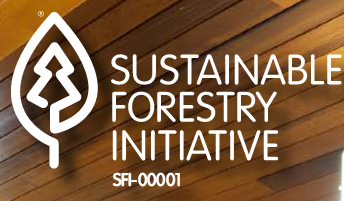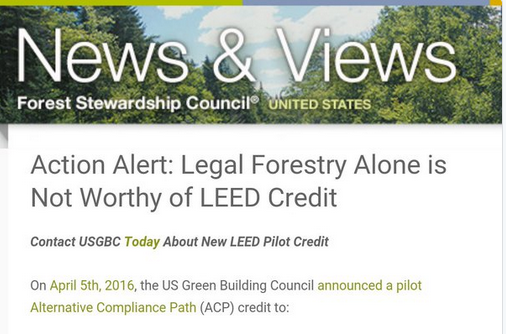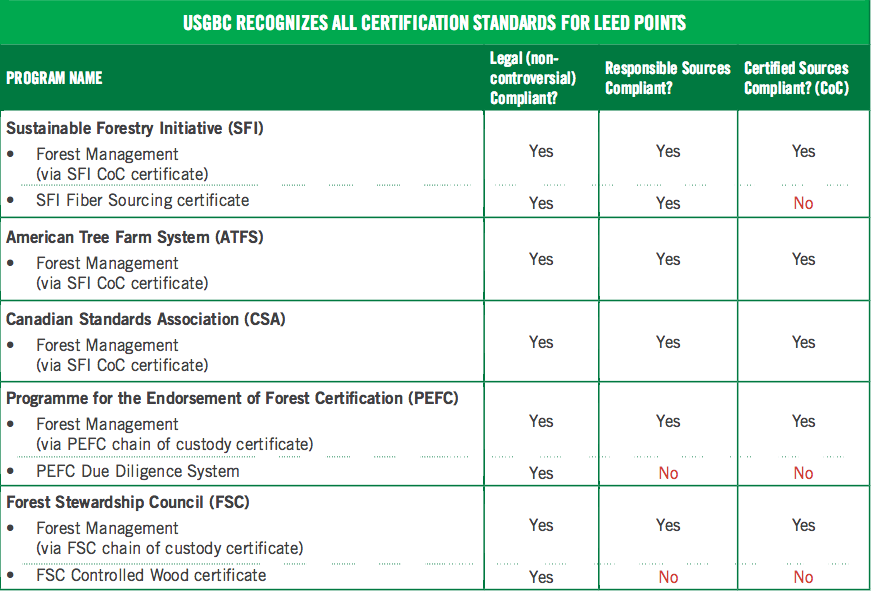It is a real pleasure to be able to share some promising news from the Sustainable Forestry Initiative (SFI). After many years of hard work, SFI staff – with support from key players in the building materials industry – have succeeded in persuading the USGBC LEED program to take a balance and positive approach to recognizing the environmental benefits of wood in commercial construction.
 LEED (Leadership in Environmental & Energy Design) is a rating system administered by the US Green Building Council (USGBC) that scores and recognizes environmental performance in building construction. Over the past decade it has become extremely influential in guiding design decisions in (mostly) new commercial projects in (especially) the public sector around the western world.
LEED (Leadership in Environmental & Energy Design) is a rating system administered by the US Green Building Council (USGBC) that scores and recognizes environmental performance in building construction. Over the past decade it has become extremely influential in guiding design decisions in (mostly) new commercial projects in (especially) the public sector around the western world.
LEED has been an important demand driver for sustainably-certified wood products for many years. It’s positive influence has been limited, however, by a very early decision to recognize and credit only FSC-certified wood. This decision was made quite early in the process and rather randomly. Once made, it was (understandably) defended aggressively by FSC-supporters – to the point where it became a real barrier to effective promotion of wood as a green alternative to other building materials like steel and concrete.
What is new?
 Last week’s announcement references a new rating format from USGBC called Alternative Compliance Paths (ACPs). This format appears to offer a more adaptive, and less prescriptive, approach to identifying and recognizing environmental attributes. According to SFI’s fact sheet, the ACP utilizes the international product standard ASTM D7612-10(2015). The same fact sheet (linked here) provides a detailed “how to” guide for using the new format to apply LEED credit for responsibly sourced wood products.
Last week’s announcement references a new rating format from USGBC called Alternative Compliance Paths (ACPs). This format appears to offer a more adaptive, and less prescriptive, approach to identifying and recognizing environmental attributes. According to SFI’s fact sheet, the ACP utilizes the international product standard ASTM D7612-10(2015). The same fact sheet (linked here) provides a detailed “how to” guide for using the new format to apply LEED credit for responsibly sourced wood products.
Significantly (and enouragingly) the format recognizes all of the SFM standards in a manner that appears sensible, balanced, and impartial. This should have the immediate effect of broadening the options and opportunities for architects, developers, and builders to incorporate sustainable wood products into building that are being promoted for their environmental performance.
Good For All
This is clearly very good news for the Sustainable Forestry Initiative. And program staff have done a very good job providing a lot of information up front. You can read all about it in their press release, a page promoting wood as a building material, announcement web page, fact sheet, and a detailed “how to” guide to the ACP process.
We think this is good news for FSC and PEFC as well. Sadly, the staff at FSC-US disagree and – within 24 hours of SFI’s announcement began campaigning against the new format. Here is their post:
 We think this approach is narrow-minded, short-sighted, and ultimately self-defeating. Virtually no one consider SFI and FSC to be identical programs. Both have significant strengths and serious flaws. If there is one area where they should be able to collaborate, it is in the promotion of markets for responsibly and sustainably produced wood products. This is especially true in an industry, like commercial construction, that is dominated by clearly unsustainable alternatives.
We think this approach is narrow-minded, short-sighted, and ultimately self-defeating. Virtually no one consider SFI and FSC to be identical programs. Both have significant strengths and serious flaws. If there is one area where they should be able to collaborate, it is in the promotion of markets for responsibly and sustainably produced wood products. This is especially true in an industry, like commercial construction, that is dominated by clearly unsustainable alternatives.
Well Done!
So please join us in congratulating the talented staff at SFI, Inc. They have done a service for the whole community. We hope to see more and more examples of the prominent use of certified wood products in LEED buildings around the world.
